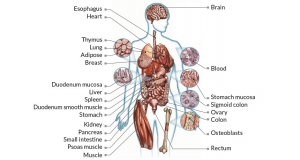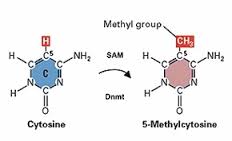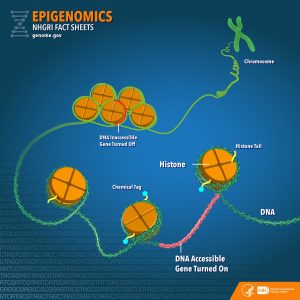Introduction
Epigenomics, or epigenetics, literally means above, or on top of, genetics. In fact, the epigenome is a multitude of chemical compounds that tells the genome what to do. The human genome contains over three billion letters of DNA, called nucleotides. These nucleotides make up a genetic code that make you, you. For more information on what the genome is, look at my previous blog, https://eportfolios.isucomm.iastate.edu/bwhite/2016/09/14/blog/#more-8. Chemical compounds and proteins that attach to DNA and direct actions like turning genes on or off and controlling the production of proteins in particular cells are what makes up the epigenome. Epigenomic compounds “mark” the genome by attaching compounds to DNA and modifying its function. This does not change the DNA sequence, but changes how the cells use the DNA’s instructions. Epigenetics is a vital key in understanding the genome and how human health works, and should be researched in depth as a way to tailor treatments to specific patients.
 https://www.sciencenews.org/article/year-review-epigenome-makes-its-debut?mode=topic&context=87
https://www.sciencenews.org/article/year-review-epigenome-makes-its-debut?mode=topic&context=87
Figure 1. Some of the tissues and cells that can be epigenetically marked and mapped.
What does the epigenome do?
Every cell in the human body is specific for different functions in organs, bones, and muscles. These cells carry the same genome in its nucleus. The epigenome makes up the chemical compounds that have been added to all of one’s DNA, which comprises one’s genome. These chemical compounds are a way to control the expression of every gene in the genome. The chemical compounds involved with the epigenome are not part of the DNA sequence, but are attached to the DNA. Many people believe that you are born with genes inherited from your parents, and that your genetics can not change. While this may be true on many levels, it is not true about epigenetics. Changes in the epigenome are considere a natural process of development and tissue differentiation. A person’s epigenome can change based on environmental factors, like: smoking, diet, and exposure to pollutants. It can also change due to disease. The changes made to the epigenome will remain as the cells divide and can be inherited through generations. Whether genes are turned on or off, the production of certain proteins in cells, and ensuring that cells only produce the proteins needed are all things epigenetic changes determine. An example of this, proteins that promote muscle growth would not be made in bone cells. For more on what epigenetics is and how it works, watch the following video:
Epigenomic modifications
Methylation is a typical epigenomic modification. During methylation a methyl group is attached to a specific segment of DNA. When the methyl groups added during methylation attach to a gene, they can turn off the gene. This results in no protein being produced from that particular gene. The methyl group can also turn on a gene, leading to protein being produced by that gene. Methylation allows the cells in the body to remember which genes are on or off.
 https://www.quora.com/How-is-DNA-methylation-related-to-senescence
https://www.quora.com/How-is-DNA-methylation-related-to-senescence
Figure 2. Cytosine made into 5-Methylcytosine through methylation. The newly added methyl group is in the red box.
The second most common epigenomic modification is histone modification. In histone modification, DNA in cells is wrapped around histone proteins, which then make spool-like structures. This enables DNA’s molecules to be wound into chromosomes inside the cell nucleus. From there, proteins can add many different chemical markers to histones. Proteins from other cells can detect these markers and decide whether that region of DNA should be ignored or used in that cell.
 genome.gov/images/content/epigenomics_factsheet.jpg
genome.gov/images/content/epigenomics_factsheet.jpg
Figure 3. Histone modification.
Errors in the epigenetic process
Many errors can occur in the epigenetic process. These errors are what lead to some diseases. The modification of the wrong gene or the failure to add a compound to the gene is an example of and epigenetic error. These two errors can lead to unusual activity or inactivity of the gene, which causes genetic disorders. Some of the genetic disorders caused by errors in the epigenetic process includes: cancers, degenerative disorders, and metabolic disorders.
Conclusion
While the genome is a very complex structure that is difficult to comprehend, scientists are using epigenetics to understand it a little better. Today, researchers are using epigenetics to map the locations and understand the functions of all the chemical tags that mark the genome. For more information on current research in epigenetics, look at: http://www.roadmapepigenomics.org/. An interactive tutorial that might help in your understanding of the epigenome can be found: http://learn.genetics.utah.edu/content/epigenetics/. Until recently it was thought that human diseases occurred largely due to changes in DNA sequence, infectious agents such as bacteria and viruses, or environmental agents. Researchers have now found that changes in the epigenome can also lead to disease. Many doctors hope to one day be able to use epigenomic maps to evaluate patients health status and determine a patient’s response to treatments. It is now more important than ever to continue studying epigenetics in an effort to better understand the human body and, ultimately, improve medicine and human health.
Hey!
Cool topic– it’s not one you usually think of when it comes to what else can affect human health. Are there any therapies being researched into reversing some of these epigenetic errors that lead to disease?
A lot of the therapies being researched into reversing epigenetic errors are being done in various cancers. For example, on the NIH website I found that doctors are using a type of chemotherapy called Azacitidine that when given at very low doses does not kill cancer cells. Instead, this type of chemotherapy coaxes genes to switch on to fight cancerous cells. Azacitidine is showing promising results in treating patients with non-small cell lung cancer.
Are there any known diseases that are caused by epigenetic modification? How close are researchers to being able to look at the genome for diseases and treatments? I have always been interested in the effects of epigenetics on diseases like cancer. I think that someday in the distant future, certain sites on the genome will be able to be methylated or unmethylated in a doctors office to help cure some diseases.
According to the NIH, heart disease, autism, Prader-Willi syndrome, and various cancers, among other diseases, are caused by epigenetic modifications. Currently, researchers are closely studying the genome and have been able to identify genes that are related to diseases. They are studying the genome and hope to one day be able to have treatments that target the specific gene that is causing the disease.
I like how you explained everything thoroughly about epigenetic. I am just wondering about what would be like the main important step to reduce or control the errors in the epigenetic process? Overall, it is very interesting to read through your post !
I found the following statement through one of your links. Is it true, or old information? There is no doubt that epigenetic inheritance occurs in plants and fungi. There is also a good case for epigenetic inheritance in invertebrates. While many researchers remain skeptical about the possibility of epigenetic inheritance in mammals, there is some evidence that it could be happening.”
Based off of what I have read, researchers and scientists have different opinions about epigenetic inheritance in invertebrates. I think that as time goes on more scientists believe that epigenetic inheritance can occur in invertebrates, but it is more common in plants and fungi.
Very interesting topic! I think your visuals are very beneficial and help to better understand the complex subject. After reading your post I wanted to know more of how the research is being used today, so I’m glad you added a link to current research. I would even suggest adding more links or a list of sites to explain the different current uses epigenetic inheritance.